
22 Nov TIO SE Asia: Into Cambodia
Though we had spent four wonderful days in Cambodian waters during our Mekong River cruise, our experience the past three days made it clear we were only getting a slice of the bounty of Cambodia.
Chhay and Sel our guide and driver had left Siem Reap at 0200 in order to meet us on the shore as we disembarked at 0830 on Saturday. Their early departure was because of Inspiration Cambodia’s proactive response to our ship being unable to enter Tonle Sap Lake- not enough water.
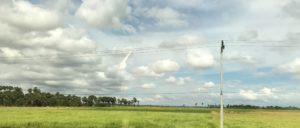
Once clear of the morning traffic of Kompong Cham, we drove for several hours through an agricultural area, with large fields of rice and the occasional palm tree as visual relief, everything green from the recent rainy season, the edge of the road and farmyards spread with mats or tarps of drying rice, just harvested. My early life was all about farming so the drive was quite interesting to me.
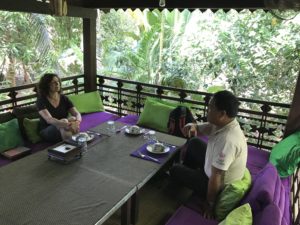
We arrived in the vicinity of Siem Reap just past noon and elected to get right into our touring schedule rather than check in to our hotel. First stop was a beautiful wooden private house which has been converted to a very special restaurant. We were the only patrons for our quiet lunch, prepared by our hostess, served by her son. After, I attempted, with limited success, to learn to play a bamboo instrument reminiscent of a jaw harp, much to the amusement of the child who demonstrated it. The rest of the family joined in the chuckle.

Ta Prohm
Then it was time to begin our tour of the temples in the vicinity of Angkor Wat. The area around Siem Reap is dotted with sites of the Angkor Empire that were built between the 9th and 15th Centuries. Our first visit was to Ta Prohm, a late 12th- century site, firmly in the grip of the Cambodian jungle. Some of the giant trees that seem to grow out of the stone have had to be cut down, as they were endangering not only the tourists, but threatening to destroy the stonework of the temple itself. Several temples later, I still am struck with a sense of awe at the scale and the artistry of these massive structures.

Bayon
Our next stop, Bayon (early 13th-century), is a more compact site. We arrived in the late afternoon, the light perfect to view and photograph the giant faces that dominate all four sides of the many towers of the temple. The faces represent the Four States of Mind of Buddhism: Charity, Sympathy, Equanimity, and Compassion.
Approaching sunset, the long drive and the heat and humidity suggested it was time to find our hotel. And Maison Polanka proved to be the perfect refuge.
Maison Polanka is a total of just two villas, ours, the “Maison,” just five suites set in a tropical garden. The hotel gave us the time and space to contemplate the grandeur of the temples we had visited.
A frosty Angkor Beer in the garden also helped.

Maison Polanka
We couldn’t bear to leave our oasis, so we chose to have our very private dinner in the hotel’s open-air dining space.
On Sunday, November 20, our first stop was a beautiful, small temple about 20 miles from Siem Reap, Banteay Srei. Chhay and Sel picked us up at 0830 for our drive into the country north of the city. This was one of the easier sites to see because we got there early and Chhay knows the best ways to beat the crowds.

Banteay Srei
Not far from Banteay Srei, the road heads up to Kulen Mountain, an area that comprises many early Khmer sites, a number of which are not accessible because of lack of roads and the landmines that remain from the years of conflict in the late- 1970s. This region figures prominently in Cambodian history as the birthplace of the Angkor Empire, where Jayavarman II declared himself supreme leader in the year 802, setting into motion a six-century domination of Southeast Asia.
We joined the throngs climbing to the top of the mountain, the culmination of which is a huge reclining Buddha carved into a large boulder. Cambodian people, there to make their offerings, were by far the most represented population.
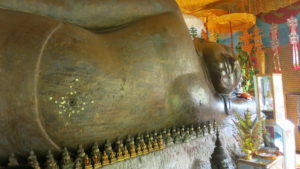
They also were there in numbers when we went to swim in the plunge pool below the largest of a series of waterfalls. It was Sunday, and crowds of Cambodian families, including babies in parents’ arms, groups of teenagers, saffron-robed monks, foreigners like us, all were reveling in the cool water on a steamy afternoon.
Many, including Chhay and me, swam against the strong current to the rocks at the base of the falls, blinded by the spray until we could gain a seat on the rocks with our backs to the crashing water. One young man climbed the rocks barefooted and was just visible behind the waterfall. We were many nationalities – Westerners, Japanese, Chinese, Thais, and mostly Cambodians – smiling and laughing together in this big natural jacuzzi.
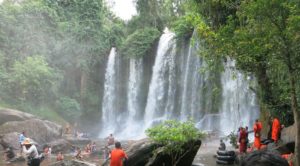
For a brief moment I reflected on the U.S. election, and the thought occurred to me that if world leaders had been in the water with us, perhaps it might have been obvious that the big concerns and the me-first attitudes that seem to dominate politics are not so important after all.
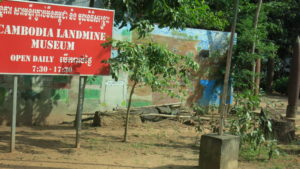
On our way back to Siem Reap, we made a stop at the Cambodian Landmine Museum, created by Aki Ra. The man had been a child-soldier during the genocide, witnessed the horrors of that period, and decided to dedicate his life later in the effort to clean up the landmines and unexploded ordnance that threatened the lives of children and adults. Much of that ordnance was dropped by American B-52s attempting to disrupt traffic on the Ho Chi Minh Trail during the Vietnamese War. Unfortunately people are still dying as a result of the devices. The Museum donates its profits to the victims.
(And for the record, in 2012, Aki Ra, a CNN Hero, was a guest of Telluride Mountainfilm.)
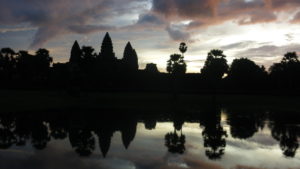
Sunrise, Angkor Wat
Monday was a very early wakeup as we were in the tuk tuk at 0500 in order to be among the international throngs for sunrise behind Angkor Wat. It is a sight that should be seen at least once.
Even though the skies were cloudy, it was an inspiring event. Later we walked through the edifice, including the climb to the upper levels. That required waiting in a long line, but the experience is worth the wait. The Maison Polanka staff had prepared a breakfast picnic and Chhay found us a spot away from the masses to enjoy it. An army of tiny ants soon joined us, but we managed to have a pleasant breakfast despite our unwelcomed guests.
We rode our tuk tuk to our next stop, which included a lengthy walk through the forest to Preah Khan. On the way to pick up our ride we met a German couple from our river trip. Small world. They also were near the end of their vacation, looking forward snow and skiing when they got home.
We too.

Through The Jungle To Preah Khan
We had lunch at Sala Bai, an NGO whose mission is to train young people in the skills needed to work in the tourist industry. The enthusiasm shown by these kids let us know they were excited to be given a chance to make a living in this growing market.
We spent another delightful evening at Maison Polanka; a swim in the beautiful pool, a quiet dinner, and to sleep early, thinking about my proposed bike ride in the countryside with Chhay the next day.


Janet niichel
Posted at 23:32h, 22 NovemberNice write up. Try to go to the butterfly farm too!